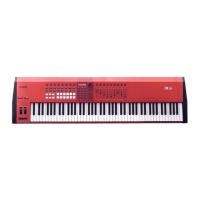
Do you have a question about the CME VX 5 and is the answer not in the manual?
| Brand | CME |
|---|---|
| Model | VX 5 |
| Category | Electronic Keyboard |
| Language | English |
Crucial safety information regarding power, connections, hearing, and environmental disposal.
Details on FCC compliance, modification warnings, and managing radio frequency interference.
Guidelines on cleaning, environmental conditions, electrical safety, and proper use to prevent damage or injury.
Highlights key features like motorized faders, advanced keyboards, and connectivity options.
Detailed explanation of buttons, wheels, pads, and displays on the front panel.
Identification and purpose of all input/output terminals on the rear.
Instructions for connecting the power adapter and the correct power-on sequence.
A visual guide and explanation for connecting pedals, microphones, speakers, and computers.
How to use page, cursor, DEC/INC, and data dial controls for navigation and editing.
Steps for normal power-on, installing drivers, and performing a factory reset.
Data list detailing control functions and MIDI data sent in MASTER mode.
Procedures for saving, recalling settings, and selecting tone banks/voices.
How to adjust the keyboard's pitch using transpose and octave shift functions.
Table listing controllers, their page ranges, and assignable data types (CC, Note, Voice).
Setting MIDI ports, channels, CC numbers, and ranges for keyboard, wheels, and pedals.
Configuring assignments for aftertouch, ribbon control, breath control, and various buttons.
How to enable zones, set ports, channels, ranges, and velocity for multi-device control.
Using the automation function to record and reproduce fader movements.
Data list for controls and functions within the STYLE SEQ mode.
Selecting songs, setting performance parts, melody, and pad hold options.
Adjusting musical scales and temperaments for expressive performances.
Settings for velocity curves, aftertouch response, and instrument data backup.
Configuration for breath control, local MIDI routing, pedal types, and MIDI filtering.
Options for resetting various instrument parameters and controllers.
Information and connection details for expansion boards.
Instructions on how to update the instrument's software via USB.
Reference lists for assignable controllers, GM voices, and musical scales.
Reference lists for musical notes, temperaments, velocity, and aftertouch curves.
Diagrams and information on MIDI signal paths and common problem solutions.
Comprehensive guide to diagnosing and fixing common problems like no sound, pitch issues, or control malfunctions.
Detailed specifications on keyboard models, functions, panel controls, and indicators.
Information on I/O terminals, power supply requirements, and physical dimensions.
Chart detailing MIDI messages transmitted and recognized by the instrument.